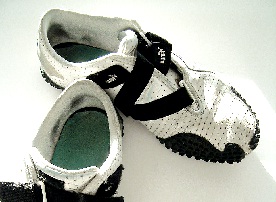 Standing in front of all the workout shoes in a sporting goods store can be a little overwhelming when you don’t really know what to look for, so we’re taking the guesswork out for you. Here’s a quick guide to picking your ideal workout shoes and remember, if in doubt, ask the salesperson! Make sure you take along a pair of socks and try to go shopping in the evening when your feet will be slightly bigger.
Standing in front of all the workout shoes in a sporting goods store can be a little overwhelming when you don’t really know what to look for, so we’re taking the guesswork out for you. Here’s a quick guide to picking your ideal workout shoes and remember, if in doubt, ask the salesperson! Make sure you take along a pair of socks and try to go shopping in the evening when your feet will be slightly bigger.
Make sure they fit your foot width and length correctly
Shoe size can vary between brands, so it’s important to check the shoe you want to buy fits correctly even if you think you know your size already. Your feet naturally expand as you run, so there needs to be a bit of room to grow especially if you are running long distances. Check that there’s around a finger width of space between your toe and the front of your shoe when your heel is pushed into the back of it. Bruised toes and potentially lost toenails can happen if you get shoes too small for you, so this step is important! If you have wide feet, make sure you get shoes with a wide sole or you’ll risk blisters on the sides of your feet.
Pick the right shoes for the job
If you want to go running, get running shoes. If you want to go running outdoors, make sure you get some sturdy trainers with good grip and plenty of support in the soles for shock absorption (soles lacking support may cause injuries in your lower limbs). If they’re just for the gym, you can choose just about any sports shoes. Remember that casual street shoes are not intended for workout use!
Know what support your feet need
If you choose shoes with too much, incorrect, or not enough support, you may get injured. This is where you need to understand pronation – the way your foot rolls when you walk or run.
The best way to find out what your feet do is to get a gait analysis done (where a shop assistant will look at the way you walk and/or may ask to see a pair of your old shoes to see how they have worn down). Underpronation, or high arches cause more wear on the outside of your foot so you will need a neutral shoe with plenty of cushioning. Overpronation, or flat feet will cause extra wear on the inside arch, and the ball of your foot which means you need extra cushioning support under your arches.
Or you can be more unscientific about it and check out your footprint – if you can see your entire footprint, you’re overpronating. If you can just see the heel and ball of your foot with a thin line on the outside, you’re underpronating. If you can see around half your arch, you’re a normal pronator and can wear just about any shoe (so try to find a shoe with neutral cushioning).
Go for a wee walk
Put the pair on and go for a little walk down the shoe aisle and back – are they comfy? Shoes tend to develop a bit of give as they wear in, however now’s the time to figure whether they generally feel good or not.
Latest shoe technologies
And then there are the shoes that have some extra features that may come in handy (or may not):
- Nike+
The latest Nike shoes have a hole on the inside of the shoe under the sole insert where you can put a Nike+ sensor chip (that you purchase separately). This amazing wee device will take your training up a notch; it detects your movement and can help you keep track of your training by recording your time, pace and distance. It links in nicely with iPods and iPhones, or you can buy a wristband that shows your progress. - Toneup shoes
These are the ones that claim to tone your legs faster and increase weightloss if you wear them during your workouts. The answer to whether these work or not depends on who you ask. The Federal Trade Commission (the consumer protections agency in the United States) recently fined Sketchers USA US$40 million to provide refunds to the people who bought their toning shoes due to a number of recent studies showing such shoes don’t help you burn more calories or help you exercise more intensely. Of course, if they make you go out and exercise more because you love wearing them you will get fitter (but the same would happen with any other shoe). They may, however affect your balance over an extended period of using them – studies are still underway as to whether this is the case and whether it’s a positive or negative effect. - ‘Barefoot’ running
You may have seen some rather odd looking shoes that look a little like toe socks with all the toes sectioned off individually and/or shoes with very little sole padding. These are based on ‘natural running’ that allow your feet to move in a natural way. Keep your ears out for this one as it’s gaining popularity…
Image / Flickr – Scataudo

